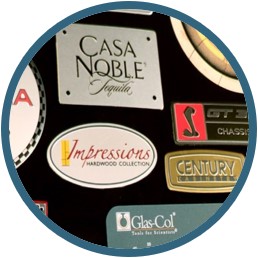One of the basic questions that is asked when a nameplate project comes is whether it is being designed for indoor or outdoor exposure. Why does this matter? Extreme temperature (hot or cold) as well as exposure to the elements like sun, rain or snow can be a big factor in protection and processes used for effective product identification. Keep in mind these when considering the material and attachment for your nameplate or label.
 Temperature Extremes
Temperature Extremes
Products that will be used indoors are not typically exposed to dramatic changes in temperature. Exceptions to this can occur and when that is the case it is important to communicate those with the information for your nameplate or label.
Outdoor environments require more attention to the material and decoration process used for brand awareness. Variations in heat and cold temperatures can affect stability of adhesives and some protective coatings. Storage temperature and application temperature can be quite different. Generally speaking, labels with pressure sensitive adhesive should be stored in a clean and dry area at 50% relative humidity and room temperature of 72°F. Nameplates with adhesives should be applied in an indoor setting and at room temperature for optimal adhesion.
Sunlight and UV Rays
Nameplates or labels that are applied to products that will be primarily used outside require specific coating and ink formulas in order to minimize fading of colors. Metal and plastic substrates provide durable and long lasting, effective branding solutions.
Rain, Saltwater, Snow
Outdoor equipment from pumps and turbines to recreational sporting goods, boats and trailers are great examples of products which need to have operational or warning labels as well as product branding badges. These types of applications take into consideration that the equipment user can be in an environment that may experience ocean waves crashing in or driving through snow-capped mountains. Protective top coats, printing processes and the type of material used for product identification can best be recommended when this exposure is communicated.
Attachment Options
Attachment is important to review because you want to be sure that the nameplate stays in place for the life of the product. Exposure to weather variations can affect what attachment is best. Many times the answer is simply to supply the nameplate with a peel and stick adhesive. Certain applications will be better served by incorporating pierced holes which allow for assembly with rivets or screws.

How Can We Help?
Designing nameplates and labels does not need to be a source of frustration. Be aware of what type of environmental exposure is relevant and communicate this as early in the project as possible. Reach out and let us help finalize the details so that the resulting part meets expectations in both quality and price. We have a variety of material and processing options for effective application to your product.
Related Posts
5 Tips for Storing and Applying Nameplates with Pressure Sensitive Adhesive
Factors to Consider for Exterior Metal Nameplates
3 Considerations for the Design of Nameplates and Labels
Common Metal Nameplate Attachment Options

